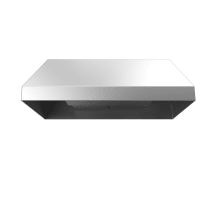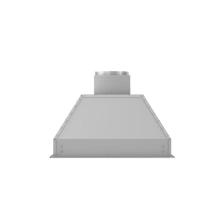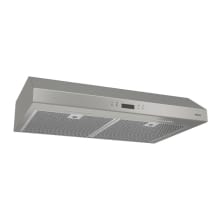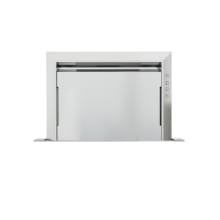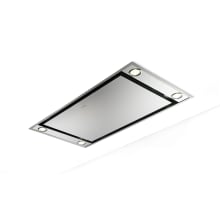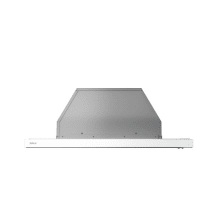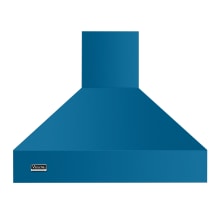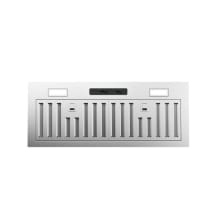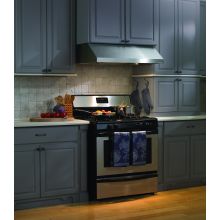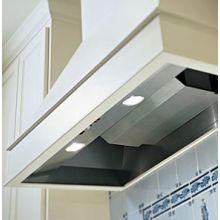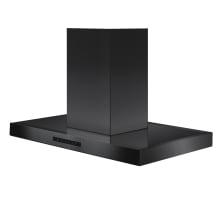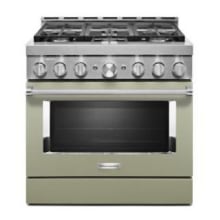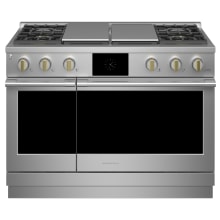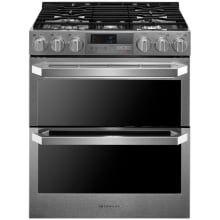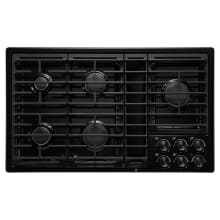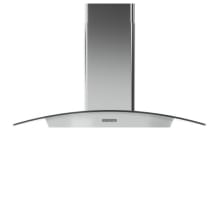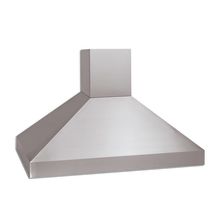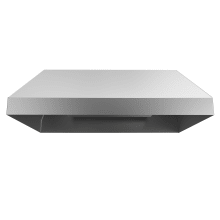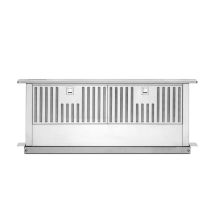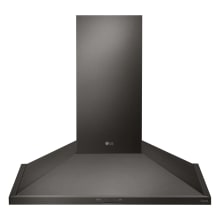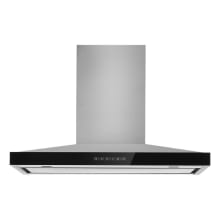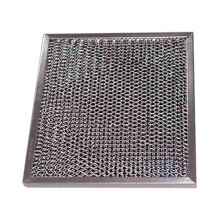How to Choose a Range Hood
Yes, your stove top needs a range hood. Here's how to find the right one for your cooking needs and kitchen size.
From the home-cooking aficionados to the time-seasoned chefs, making a mess in the kitchen is inherent in the craft. It’s in the air, no matter how careful and precise the culinary artist — grease, fumes, gases, and of course, food splatter. That is where the always-useful range hood comes in to save the day.
What Is a Range Hood?
Range hoods are a vital component to every kitchen, removing odors, smoke, and harmful particles from the air you breathe as you cook. Using powerful fans, the air around the cooktop is pulled through filters or into a duct to send out of the house. Smoke, heat, moisture, microscopic food particles, and other impurities are filtered out or removed from the kitchen entirely to prevent it from contaminating the air, or your food.
Do You Need a Range Hood?
The short answer is: Yes, you need a range hood. The more debatable questions are what kind of range hood will work for your space, and how big should one be for the cooking that happens in your kitchen?
There are a few basic but important considerations for homeowners when planning to include a range hood in their kitchen update:

Kitchen Safety
When surprises happen in the kitchen, from the kids’ cooking experiments to something more serious and smoky, concentrated fumes and gases such as carbon monoxide can accumulate unnoticed. It’s best to filter in clean air as soon as possible, and remove the dangerous air entirely, for the safety of your whole household.

Cleanliness and Upkeep
In addition to dispersing the lingering cooking smells clogging the air, range hoods direct the equally unseen particles of grease and food up into the filters and ductwork. This helps keep them away from the cooktop and counters, minimizing the amount of crusty, cooked-on, food-mess to clean up from the backsplash tile and other surrounding surfaces.

Range Hoods Offer an Extra Light Source
Many range hoods offer bulbs or light panels under the hood, aimed down at the cooktop. This adds convenience to your meal prep and cleanup by putting the light right where you need it, over the working space as you cook.

Added Property Value
Range hoods are an improvement and investment in your home. They add safety and access when dealing with the dark corners of the back-lit burners. They remove hazardous materials from the air and minimize the accumulation of cooking grime. In other words, range hoods are in demand. Having a range hood properly installed in the kitchen is an option that many home buyers are looking for as standard.
What Is the Difference Between Range Hoods?
Because every kitchen is different, range hoods have been designed to fit a variety of spaces and tasks. There are a few general standards to be sure a range hood covers when looking for the best fit. This helps narrow down the right hood for the job on the first try, rather than make-do with a product that is less than perfect.
Ventilation Options
The entire function of the range hood is to keep the air clear, to provide safe ventilation to the kitchen. There are different ways to achieve this goal, depending on the requirements of the space.

External Venting
The most effective way to clear contaminated air from a smaller room is, of course, to remove it entirely. That means sending the air outside through fans that push it along internal ductwork in the ceiling or against the wall. The ducts then vent outside of the home or attic space and should be paired with a backdraft damper to prevent external wind or moisture from blowing back into the pipe.
- Side wall caps are used where the vent ends below the roof line, which requires that the duct pipe form at least one elbow or turn at a 90-degree angle to vent the air out.
- A roof cap is used when the pipe is taken through the ceiling to be directed out of the roof at a more gradual angle, requiring less initial force to push the air through.

Recirculating Vent
Recirculating range hoods are also referred to as ductless range hoods, as some types are not connected to pipes or ducts required to channel the air outside. They are designed with the intent of cleaning the air and disposing of odors before releasing it back into the room. Under-cabinet range hoods are a prime example of recirculating ventilation.
When there’s not enough space to route duct pipe from the range hood to the outdoors, the fans of a recirculating range hood instead pull the air through filters to scrub out and catch the grease and food particles. Charcoal, fiber, or ribbed plastic filters work well at purifying the contaminates. The filters will need to be cleaned or replaced every few months, but are very effective overall.
Common Filter Types

- Aluminum mesh filters use layers of grids of fine aluminum and fibers to help trap the contaminated air. These filters are easily washed, either by hand or some possibly in the dishwasher, and can be reused many times.
- Charcoal filters are used most often in recirculating range hoods. They trap carbon-based impurities and remove them from the air. These filters should be replaced twice a year.
- Residue cups are used to help collect and trap oil and grease from above and around the cooking area. They should be hand washed with soap and hot water.
Range Hood Type
Some offer a large coverage area, others guarantee even small kitchens and apartments can have the benefit of the range hood. Read on to learn the type that suits your home’s kitchen and your budget.
Wall Mounted Range Hoods

Wall-mounted range hoods resemble the look of a fireplace chimney in shape, but are more commonly made from metal in today’s kitchens. They are wide at the base, at least the width of the cooktop, and they often taper to a narrower column at the top. The classic look of the chimney over the cooktop suits many kitchens, especially open floor plans, or kitchens with large, professional ranges. A large oven and stove top is a natural focal point for any size room, and the wall-mounted range hood offers a nice visual balance.
Island Range Hoods

When the cooktop is in the middle of the kitchen, the airflow demands on the range hood are slightly different. Island range hoods cover a larger, more direct surface area without the assistance of walls to help channel the heat and moisture. These hoods are ducted into the ceiling to pull the contaminated air, smoke, and fumes directly out of the home. The shape of an island hood is similar to the wall-mounted range hoods - wide at the base and narrow at the top - but the island hood will be designed for 360-degree viewing to draw the eye as a stylish feature of the kitchen.
Under-cabinet Range Hoods

For the modern busy family, kitchens are likely functional and economical with their design, which is where the under cabinet range hood comes in. The range hood is mounted under the cupboard cabinets and has a hood the size of the cooktop to help catch the rising smoke, moisture, and heat. These allow safe storage space above the stove and cooktop. Any ducting is hidden behind cupboard doors, with cupboard niches between the ducting and the next cabinet. Under-cabinets are great for smaller kitchens and apartments where venting outside isn’t a ready option. Often, under-cabinet range hoods are primarily air filters and will clear the air without venting it outdoors. Both options are available, so consider which design will work best in your home, on your budget.
Hood Inserts

Insert hoods are a favorite of interior designers and contractors because of the customized layouts they allow in the kitchen. These powerful hood inserts tuck away into a custom designed hood to match the style of the rest of the room, from wood to brick and metal, they are intended to allow you to construct your own hood, of any size or shape. They can be less expensive to purchase as a unit, but when added to the cost of creating a custom hood, these inserts can get pricey.
Downdraft Range Hoods

For a trendier, edgier look to the kitchen, a downdraft range hood brings in brilliant telescoping technology that allows the hood to hide away when it isn’t in use. Rather than send duct vents into the ceiling or wall above, pulling the air up to be filtered and removed, downdraft hoods vent out through smaller pipes installed below the cabinets. Layers of fans and filters combine with modern tech to force the air away from the cooking workspace. With the press of a button, the unique design then drops the fan out of sight until it is needed again. Because of this, downdraft range hoods work best in open concept kitchens or smaller homes that need to save on visual space.
It’s worth noting that heated air is naturally more inclined to rise, which works to the advantage of wall-mounted or island range hoods, and presents more of a challenge to the downdrafts because they are designed to work against such heat dynamics.
CFM Power
A kitchen range hood should be capable of filtering or circulating all the air in the room once every 4 minutes. That’s entirely circulating the air 15 times in an hour of use. The amount of air range hoods can move is measured in cubic feet per minute, or CFM. The higher the CFM, the faster the air can move. It will probably also add to the noise level, but manufacturers will note the sones to help you find the quietest option for the CFM range you’re looking for.
To find the CFM range needed for your kitchen, it requires a pretty easy bit of measuring and math. These are just general guidelines to help narrow down the wide field of choices. It’s important to always check the specifications from the manufacturer, or consult with your contractor or architect for new projects to be sure everything installed is up to code for your area.
Start with the kitchen measurements and work out the cubic foot dimensions. You’ll need the length, width, and height of the entire room, or kitchen area. Multiply the length, width, and height together. That’s the cubic foot size of your kitchen.
As an example, a kitchen that is, wall to wall, 10’ by 10’ by 8’ would be measured out like this:

(Length in feet) x (width in feet) x (height in feet) = CF
That comes to 10’ x 10’ x 8’ = 800 cubic feet. In order to determine the CFM for an 800 CF kitchen, divide the cubic feet total by 4, since you’re looking for something strong enough to power through the entire room once every 4 minutes. In our example, that leaves us with 800 CF / 4 = 200 cubic feet per minute. An 800 CF kitchen, then, would need a range hood with a minimum of 200 CFM to effectively remove contaminants from the air.
Another consideration is the range hood’s appropriate fan size over the stove. No matter the size of the room, the range hood should be capable of dealing with the size stove you’re working with. It’s a good idea to have a minimum of 100 CFM per 12” of stove width. Assuming the average stove is around 30” wide, that breaks down to 2.5 feet wide, and the CFM required would be 250. The formula for determining the minimum CFM for your stove looks like this:
(stove length in feet) x 100 CFM = minimum stove CFM
Keep in mind that gas stoves generate more heat and fumes than an electric stovetop is capable of, so a gas stove will require a higher CFM to process the air demands, regardless of the room size. For these stoves, look to the BTU of the burners combined, rather than the stovetop size. (The BTU is the standard measurement for the amount of heat produced.)
For instance, let’s assume that the average gas stove top has four burners, and each burner is capable of 10,000 BTU. The stove top then has the potential to generate 40,000 BTU at one time that the range hood will have to help scrub and disperse. Divide the total BTU by 100 and you arrive at a minimum CFM of 400 CFM.

Finally, if you have an external venting range hood, consider the ductwork’s impact on performance. The vent allows air to flow both ways, though a dampener should reduce unwanted airflow into the house. That creates additional resistance to the range hood fans pushing the air out of the kitchen. You compensate for this by adding to the CFM power of the range hood. For each foot of pipe between the range hood and the external vent, add one CFM; for each 90-degree or elbow turn that the pipe takes, add 25 CFM; and for the external vent cap, add 40 CFM.
- 1 foot of duct pipe = 1 CFM
- 1 pipe elbow = 25 CFM
- 1 external vent cap = 40 CFM
Therefore, if you’ve got 5 feet of vent pipe, the duct bends twice to get it outside, and an external dampening cap is installed, you end up with an extra math formula to work out:
5 + 25 + 25 + 40 = 95 CFM
Plan to add an extra 95 CFM of power to the rating of your range hood, in addition to the greater of the CFM rating results of either the room size, stove size, or burner BTU required CFM. In our previous examples, the room size requires a minimum of 200 CFM, while the electric stove requires 250 CFM, and the gas stove requires 400. In that instance, to account for the draft of an external vent, an 800 CF kitchen area with an electric stove would require a 345 CFM or higher range hood, while the gas stove would require a 495 CFM or higher range hood.
Avoiding Backdrafts, and Makeup Air Systems
It goes without saying that in order to remove air from a room, there must be a simultaneous replacement source. For most homes, this is handled by an open floor plan, air leakage around doors and windows, and/or more specialized ventilation. For others, a high-powered range hood can pull too much air from the room, impacting other areas of the house and pulling air from sources like the chimney, HVAC, or laundry exhausts. This is commonly referred to as backdrafting.
As of 2009, the International Residential Codes (IRC) require that exhaust hood systems capable of over 400 CFM be able to match the exhaust system’s outflow with an equal makeup air ratio. Since then, various ways have been developed by manufacturers and building professionals to address the issue for homeowners. They involve everything from replacing water heaters and other appliances with sealed combustion appliances that don’t require venting, installing dampeners and extra exhaust grilles, to balanced ventilation systems via HRV (heat-recovery ventilator) systems and blowers, and more.
There is no one-fix solution to tightly sealed homes that experience backdrafting. Every location, climate, and construction variance will have to be considered, from issues such as humidity and moisture load, to the existing HVAC equipment, and other vented appliances.
Every home layout is different and unique, so use the provided formulas to help narrow in on your design choices and goals. Always consult the local building codes and other professionals for the final installation specifications and recommendations on your individual project.
What to Look For
Each kitchen will have a unique layout to match the individual habits of the home chefs who uses it, but there are some features on range hoods that are predictably useful and important to have.

Finish, Style, and Location
The range hood is a noticeable, attention-drawing design element in your kitchen. Because of this, it’s important to find a design that complements the overall look of your kitchen. Look for a finish color or material that works with the other elements in the room, as well as a shape and size that fit the surroundings and look balanced.
Fan Speeds
Though many brands offer up to six speeds, many cooks will find three speeds to be sufficient: always be sure there are at least high, medium, and low settings available to get the job done. The in-between speeds are nice to have and are useful for keeping the room’s pressurization level from changing drastically by pulling air at a higher CFM, or for operating at quieter, idle settings.

Lighting
The range hoods can cast shadows between the kitchen’s overhead lighting sources and the working surface over the stove. It’s very important for most households to have the option of interior lighting under the hood at the press of a button. The lighting options can include LED, fluorescent, incandescent, or the ultra bright halogen bulbs, and can be used safely while cooking, or some as night-lights in dim kitchens..
Range Hood Bonus Features
If you have the room in your budget, these extras can help make the kitchen life a little easier.

Electronic Controls
It’s all about the options when you have push-button and digital electronic panels to customize the airflow exactly as is needed.
Exhaust Timer/ Auto Shut-off
After a dinnertime cooking marathon, set the range hood to filter the air. No more waiting around to switch off the exhaust because it turns itself off after a preset time period.
Heat Sensors
When the temperature heats up around the cooking area, the range hood can adjust the blowers to a higher setting and vent the air more quickly.

WiFi and Smart Device Compatibility
With some brands and models, even the range hood can be controlled on your favorite devices, so you can change the settings from any room.
Safety Tips for Choosing Your Range Hood
Basic kitchen safety still applies, even with a range hood. Keep in mind that cooking over open flame is still inherently dangerous, even in the kitchen. Gas fires can flare up by stoking the flames with extra airflow, so always be careful when cooking over gas ranges, especially those with range hoods. Automatic, heat-sensing range hoods are very useful, but they are not a solution for cooking fires. Here are a few other important considerations for safety when you choose a new range hood for your kitchen.
Allow for working space in your cooking space.
Plan on installing the range hood 18” to 30” above the cooking surface. The goal is safe space to work over the stove, as well as provide good lighting and plenty of venting height.
Go big for your home...
The bigger the hood, the more effective it will be. Look for a range hood that is larger than the cooking surface, with at least 1” to 3” extra on all sides. This helps ensure all air is caught surrounding the stove top.
But Less is sometimes More.
The shorter the distance of ducting pipe the dirty air has to travel through, the more effective the range hood will be at pushing the air out. That means, if at all possible, there should be no more than two 90-degree angle bends between the stove top range and the vent outside of the home.


